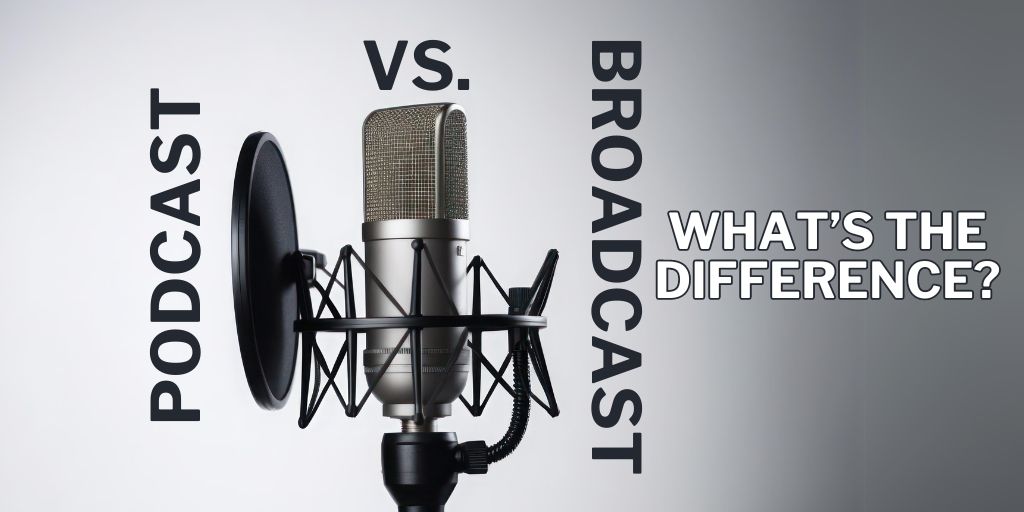While podcasts and broadcasts are both powerful mediums to inform, educate, and entertain audiences, the similarities end there. They differ significantly in delivery method, format, and control. In this article, let’s discuss the differences between podcasts and broadcasts.
What Are Podcasts?
Podcasts are pre-recorded audio or video files that are published on the internet. They have gained a lot of popularity in recent days because of the convenience they offer.
According to statistics, over 50 million people, on average, listen to podcasts every month, making it an excellent platform to convey your message. Podcasts are effective if they cater to the needs of your target audience.
What Are Broadcasts?
Broadcasts refers to the transmission of audio or video content to a wide range of audiences through radio, TV, and, in some cases, live streaming on the internet. They have been around for decades, so their user base is larger. Broadcasts can give you immediate results but can be expensive.
Differences
Here are the differences between podcasts and broadcasts.
1. Delivery Method
Podcasts utilize the internet to distribute audio or video content. They are available for streaming or downloading through websites or platforms like Apple Podcasts, Spotify, Libsyn, Stitcher, Tunin, Google Podcasts, and many more. The user can assess the shows at their convenience.
Broadcasts use radio, television networks, and other electronic mediums to transmit audio or video content. Currently, the user can only view not only in the specific time when it’s broadcast, but also access direct streaming on several networks.
2. On-Demand vs. Live
Podcasts are many times pre-recorded and available on demand. The users can view the content at any time, allowing for flexibility in when and where to consume the content. However, some podcasts may be live.
Broadcasts are live or real-time. The programs are scheduled, so the users need to tune in at a specific time to view the content. Broadcasts provide a more immersive experience.
3. Accessibility
Podcasts are accessible through the internet and compatible devices such as a computer, smartphone, or tablet. This digital distribution gives podcasts a global reach, making them available to a worldwide audience. But till you gain popularity, not many will view your podcast.
Broadcasts are accessible through radio or TV, depending on the type of broadcast. Being within the signal range is necessary to view the broadcast, so there will be limitations in the reach. But this is changing daily and most Broadcasts are available on demand.
4. Format
Podcasts include various topics, from interviews to talk shows to educational content.
Broadcasts often include topics on many subjects that appeal to broad audiences.
5. Ownership
Podcasters have more control over their content. They will have some restrictions if they publish content on Spotify or similar platforms, but they are generally lesser than those implied by media networks. If you publish podcasts on your own website, you’ll have complete control over them.
Broadcasts are usually published on large media networks. These networks sometimes control the distribution and content of their channels, so the creators will have a set of guidelines to follow and have guidelines or standards that meet larger audience requirements.
6. Monetization
Podcasts are monetized through advertisements, sponsorships, subscriptions, donations, and merchandise sales.
Broadcasts are monetized through advertisements, sponsorships, and, in some cases, subscription fees. The monetization method can vary depending on the type of broadcast.
FAQs
Which medium generates higher ad revenue?
Broadcasts generate more ad revenue, because of their wide audience reach. You can also make a good amount of money through ads in podcasts, but you’ll need to build a large audience base. This can be accomplished by hiring experts who know the industry.
Can I repurpose broadcast content for podcasts and vice versa?
Yes, but you’ll need to make some changes to fit the distribution method. For example, if you’re repurposing broadcast content for podcasts, you’ll need to remove the mentions of broadcast times.
Which medium is more sustainable in the long term for content creators?
If you have a mission to get your message in the world, and want a larger reach then broadcast is a better choice. But if you are just starting out and have no experience in media, the podcasts win hands down. This is a great way to start out.
Conclusion: Which Is Better?
Well, there’s no specific answer to this question because both podcasts and broadcasts have their own advantages and disadvantages. If you have a higher budget and want to reach a wide range of audience in a shorter time, broadcasts are your best bet.
Choose podcasts if you are starting out and want to get your show up and running quickly. They will start giving you good results once you build an audience base.
Many individuals and businesses combine both to achieve the best results.
Ken D Foster is a best-selling author, transformational leader, business strategist, and producer of the Voices of Courage Show, syndicated in 185 countries. He is available to have a conversation with you about Broadcasting on his Network TCN (The Courage Network. Set up a time with ken at: http://KenDFoster.youcanbook.me

